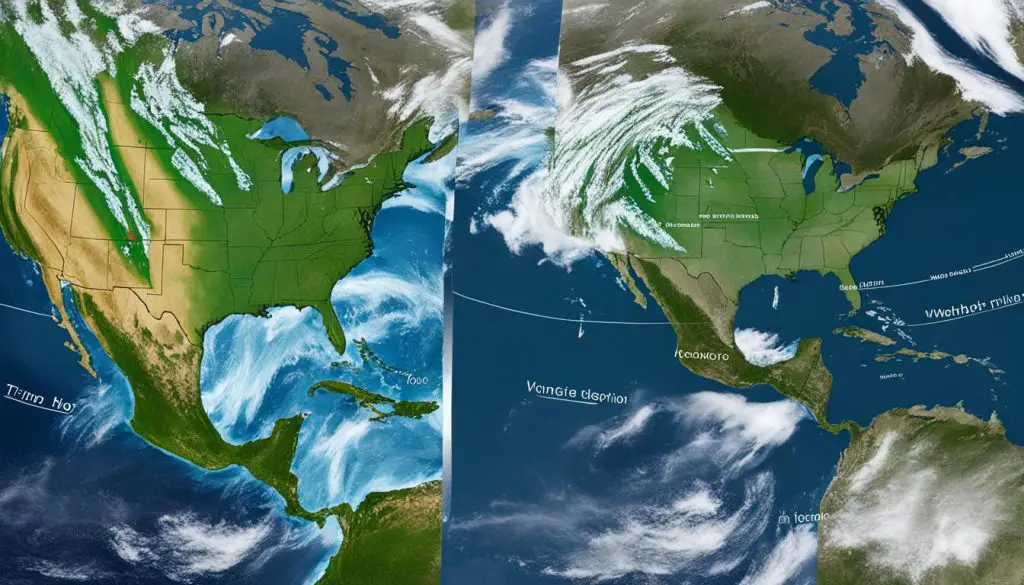
Have you ever wondered about the difference between weather and climate? Although both are intertwined, they are distinct in their own ways. When you think of weather, you’re considering what will dictate your outfit for the day. The weather definition would tell you it’s a mix of events that occur in our atmosphere on any given day—like the rain you grab an umbrella for, or the sun that calls for your favorite sunglasses. These conditions are influenced by air pressure, temperature, humidity, wind speed, and direction.
On the flip side, when discussing climate definition, you’re delving into the narrative of the environment over a lengthy timespan. Climate is what you’d expect, the staple pieces in your wardrobe throughout the years, based on long-standing averages and patterns. It represents the regular rhythm of weather that defines a region, taking into account the extremes and peculiarities over a sustained period, often over 30 years, known as Climate Normals.
Understanding the essentials of weather vs climate is more than an academic exercise—it deeply affects how we live our lives, from choosing what to plant in our gardens to understanding how global weather patterns are shifting. It’s a key to deciphering both the immediate impacts on our daily affairs and the long-term strategies we must develop to thrive on an ever-changing planet.
Weather is the weather conditions in a certain place in a short period. We use temperature, moisture, atmosphere, wind direction/speed, precipitation, visibility, etc. to describe the weather of a place.
All these sentences below describe weather. Note that the time effectiveness mentioned is short-term.
- The weather today will be sunny and warm. It is a good day to do some outdoor activities.
- The probability of rain tomorrow will be 80%. You better bring an umbrella with you when leaving home next morning.
- It will be snowing in New York next week. Are you sure you still want to go visit your friend there?
Climate is the weather conditions in a certain place over a long period. According to the World Meteorological Organization, it requires at least 30 years of weather statistics to indicate the climate of one place. The climate is affected profoundly by geographical location, altitude, and terrain.
All these sentences below describe climate. Note that the time effectiveness mentioned is long-term.
- Florida, US, is known for its pleasant climate and attracts people to live there after retirement.
- Due to the high altitude, Mexico City is cool even during the summer.
- Many countries in Northern Africa belong to the desert climate. It seldom rains and people are suffering from drought.
To sum up, weather represents a short period of weather conditions, whereas climate shows a long period of weather conditions
Key Takeaways
- Weather involves the day-to-day atmospheric conditions that dictate immediate choices, such as apparel and activities.
- Climate refers to the expected pattern of weather over a long period, informing us about seasonal wardrobes and lifestyle adaptations.
- Climate Normals are 30-year averages of weather that refine our understanding of a region’s typical weather conditions.
- The weather definition includes elements like precipitation and temperature on a short-term basis.
- The climate definition encompasses the broader picture of environmental trends and patterns that last over decades.
- Recognizing the difference between weather and climate is crucial for environmental awareness and future planning.
Defining Weather: Your Daily Forecast Explained
Understanding the weather meaning in your daily life involves grasping the ephemeral nature of short-term atmosphere changes that each day brings. When you look up the daily weather, you’re peering into a complex system that is the result of the interaction of various weather characteristics such as precipitation, temperature, humidity, wind direction, and atmospheric pressure.
These atmospheric elements can shift rapidly, causing the bright sunshine to give way to a passing storm, or a brisk morning to develop into an unexpectedly warm afternoon. To aid in your daily planning, meteorologists analyze vast amounts of data sourced from advanced tools—satellites and ground-based weather stations—to predict these ever-fluctuating conditions.
Weather forecasts are more than just a part of your morning routine; they are a critical component of many aspects of life, from deciding when to plant crops in agriculture to ensuring safety in aviation, and even to strategizing and response in disaster management scenarios. The catalyst for these transformations is the unequal heating of the Earth’s atmosphere by the sun, driving the formation of winds, clouds, and the developmental patterns of storms.
Let’s dive into a comparison of key weather elements and how they’re measured:
| Weather Element | Characteristic | Common Measurement Tools |
|---|---|---|
| Precipitation | Type and amount of water falling | Rain gauge, Weather radar |
| Temperature | Heat content of the air | Thermometer, Satellite sensors |
| Humidity | Amount of moisture in the air | Hygrometer, Psychrometer |
| Wind Speed & Direction | Wind movement patterns | Anemometer, Wind vane |
| Atmospheric Pressure | Air weight pressing down on Earth | Barometer, Altimeter |
By keeping in tune with weather forecasts, you’re not simply choosing the right attire or deciding the ideal day for a picnic. You are also engaging with a vital resource that touches upon every segment of human life — from food production to the economics of industries reliant on clear skies or snowy slopes. Weather, in essence, commands a powerful influence over both the routine and extraordinary events that define our lives.
Difference Between Weather and Climate

It’s easy to discuss the weather; it’s a topic that crops up in everyday conversation, perhaps due to its immediate impact on our daily plans. However, when it comes to climate meaning and its broader implications, such as climate change and global warming, these subjects encompass a much larger scale of long-term atmospheric changes. Grasping the complexities of both weather and climate is essential in understanding how local weather observations translate to the broader scope of regional and global environmental trends.
Timescales of Weather and Climate
While a sudden thunderstorm or a brisk sunny day falls within the realm of weather, characterized by immediate, short-lived atmospheric conditions, climate deals with systematic weather patterns and climate characteristics over decades. Think of weather as the mood of the atmosphere, prone to change at a moment’s notice, and climate as its personality, developed over many years. This distinction is crucial when looking at environmental data to predict extreme weather events or establish credible climate records.
Weather Patterns vs. Climate Averages
The regularity of seasonal shifts, precipitation levels, and temperature ranges are all part of climate patterns that paint a picture of how a region’s atmosphere behaves over an extended period. This information is contrasted against daily weather patterns to determine deviations and anomalies, which may signify larger trends in the climate. While the weather can surprise you on any given day, the climate’s consistent nature allows for predictable weather scenarios based on historical averages known as Climate Normals.
Understanding the Significance of Climate Normals
In the journey toward comprehending overall climate change, the concept of Climate Normals serves as a fundamental building block. Derived from at least three decades of weather observations, these averages are invaluable both for short-term weather forecasting and for identifying shifts in regional climates. Let’s consider the Climate Normals and how they help articulate the narrative of our evolving environment:
| Climate Normal | Role in Weather Prediction | Role in Climate Analysis |
|---|---|---|
| Average Temperature | Assists in preparing for seasonal temperature expectations | Indicates warming or cooling trends over time |
| Precipitation Patterns | Crucial for agriculture and water resource planning | Reflects shifts in regional and global water cycles |
| Extreme Event Records | Utilized in designing infrastructure and emergency services | Helps to assess the increasing frequency of extreme conditions |
As we adapt to an ever-changing environment, Climate Normals offer a solid foundation upon which we can anchor our expectations, enabling society to respond more effectively to both predictable weather and extraordinary meteorological occurrences. Engaging conscientiously with these environmental data helps us to navigate the challenges posed by climate change while ensuring informed decision-making for a sustainable future.
Interpreting Climate Patterns: Beyond the Daily Weather
When you hear about global climate, you’re looking at the big picture, far beyond the clouds hovering above today or tomorrow’s promise of sunshine. It’s the intricate mosaic of various regional differences in climate stitched together, creating a planet-wide tapestry that has evolved over millennia. Yet, this grand scene is not without transformation. The climate change impact that we are witnessing today is profound, reshaping environmental patterns and thus, life as we know it.
Imagine the vast polar ice caps and the lush tropical rainforests as part of a complex climate system. Their existence, though geographically distant and climatically opposite, are interconnected parts of our world’s environmental equilibrium. Now picture the changes: ice melting at the poles, forests facing drought and fire, and storms growing in intensity. These aren’t just faraway events on a newsreel; they’re the symptoms of a shifting equilibrium, affecting every facet of regional and global climate.
- Polar Changes: Decreased albedo effect due to melting ice, leading to further warming.
- Tropical Variability: Intensified weather events driven by greater heat and moisture levels.
- Agricultural Implications: Shifts in growing seasons and crop viability due to changing precipitation patterns.
Humans are both actors and audience in this play of climate dynamics. Our actions, particularly the release of carbon dioxide (CO2) from burning fossil fuels, have become accelerants to the natural pace of climate change, adding a man-made layer to the natural stratification of environmental patterns. These human-induced factors sit atop the natural influences, like solar radiation, complicating the delicate balance our ecosystems rely upon.
You may find that your understanding of the weather, rooted in the short-term, could use the depth that comes from recognizing the long-term narratives of climate patterns.
To grasp the breadth of climate’s narrative, we must acknowledge the nuanced complexities of its scope, spanning the minute to the monumental. We are witnesses to an evolving environment that bellows a call to consciousness and action—one that asks us not just to notice but to care.
As you step out of your front door into today’s weather, consider that you are stepping into just one frame of a far larger canvas—a canvas that depicts the average of countless days like today and dramatically different from today. That canvas is the climate, an illustration of environmental patterns that defines regions, and in aggregate, our whole planet. Recognizing these patterns is your first step toward meaningful engagement with our rapidly changing world. Your awareness is the bedrock upon which we can build resilient, informed communities, capable of not only withstanding the impact of climate change but also working towards a sustainable future.
Conclusion
The intricate interplay between weather and climate undeniably shapes our world. You’ve witnessed firsthand how weather events impact your daily plans, but these phenomena also represent the subtle whispers of larger environmental shifts at play. The stakes are high as global temperatures continue to ascend, ushering in a host of climate change effects that reach every corner of Earth. From surging sea levels to shifting precipitation patterns, the impact extends far beyond inconvenient weather conditions, threatening the vitality of entire ecosystems, the viability of crop production, and the safeguarding of necessary water resources.
The Impact of Weather and Climate on Our World
Understanding the vast and sometimes devastating consequences of these changes empowers us to take mindful steps in climate adaptation. With the advanced extreme weather prediction technologies at our disposal, preparedness becomes less a question of if and more a question of how. As torrential rains, and scorching heatwaves increasingly appear in headlines, the significance of tracking and responding to the shifts in our climate cannot be overstated. Not only does this vigilance safeguard human health and well-being, but it also works to protect the cherished features of protected landscapes and biodiversity hotspots, preserving their integrity for future generations.
Adaptation and Awareness: Preparing for Future Changes
Your awareness and engagement are critical as we approach the threshold of sustainable development and climate change mitigation. Global initiatives like the IPCC, the collaborative efforts under the Paris Agreement, and the ambition of the United Nations Sustainable Development Goals reflect a unified outcry for urgent action. Recognizing the signals of climatic shifts camouflaged within daily weather patterns equips us to better anticipate and adapt to the challenges ahead. The mission transcends borders and sectors, aiming to curb the ascent of global temperatures, reduce the human cost associated with extreme events, and secure a fertile and resilient planet. With every step taken in this direction, your role in shaping a sustainable legacy becomes ever more crucial.
FAQ
Q: What Is the Difference Between Weather and Climate?
A: Weather consists of short-term atmospheric conditions like temperature, humidity, and precipitation in a specific area and can change from minute-to-minute and day-to-day. Climate, on the other hand, is the average of these weather conditions over a longer period, typically 30 years, describing the expected weather patterns in a region.
Q: How Would You Define Weather?
A: Weather is the mix of events happening in our atmosphere at a given time, including factors like atmospheric pressure, temperature, humidity, wind speed, and direction. It’s what you experience daily and can fluctuate rapidly within short periods.
Q: What Are the Characteristics of Weather?
A: Weather characteristics include the day-to-day state of the atmosphere regarding temperature, air pressure, humidity, wind, and precipitation. These characteristics are dynamic and can lead to weather events such as thunderstorms or sunny days.
Q: What Does Climate Mean and What Are Its Characteristics?
A: Climate refers to the long-term atmospheric behavior over extended periods, providing a statistical description of weather patterns of a region over time, including averages, extremes, and variability. Climate characteristics encompass temperature ranges, precipitation patterns, and typical wind speeds expected in a region over decades.
Q: How Do Weather Patterns Differ From Climate Patterns?
A: Weather patterns are short-term events and changes in the atmosphere that can be predicted for a limited time, while climate patterns are the longer-term averages of weather over a specific period. Climate patterns indicate more consistent and sustainable environmental conditions such as a region’s temperature trends, humidity averages, and seasonal weather.
Q: Why Is It Important to Understand Climate Normals?
A: Understanding Climate Normals, which are the 30-year averages of climatological variables like temperature and precipitation, is important for predicting the weather, planning for agricultural activities, and preparing for weather extremes. They provide context for whether a particular weather event is irregular or within the expected climate range of an area.
Q: How Can We Interpret Climate Patterns?
A: Climate patterns can be interpreted by analyzing long-term data collected from various regional climates, which helps to understand the broader impacts of the global climate on local environments. This data provides insights into large-scale trends like global warming and the potential for more frequent extreme weather events.
Q: What Is the Impact of Climate Change on Weather?
A: Climate change is leading to alterations in weather patterns, intensifying certain weather events such as hurricanes, causing drastic changes in precipitation, and resulting in more extreme temperatures. It can significantly affect agriculture, water resources, human health, and biodiversity.
Q: What Is the Significance of Predictable Weather?
A: Predictable weather is significant as it aids in daily planning and preparation for activities such as agriculture, travel, and outdoor events. It also plays a critical role in disaster prevention and management, allowing for timely warnings and emergency response planning.
Q: How Can We Prepare for Environmental Shifts Due to Climate Change?
A: Preparation for environmental shifts involves understanding climate models, maintaining adaptive strategies to cope with extremes such as heatwaves or heavy rainfall, improving infrastructure resilience, creating sustainable environmental policies, and raising public awareness about climate change and its effects.

























